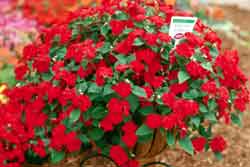Information Possibly Outdated
The information presented on this page was originally released on May 14, 2001. It may not be outdated, but please search our site for more current information. If you plan to quote or reference this information in a publication, please check with the Extension specialist or author before proceeding.
Many flowers thrive in summer's shade
By Norman Winter
MSU Horticulturist
Central Mississippi Research & Extension Center
With spring bedding plant season in full swing, many gardeners are faced with trying to add beds of color to shady areas of the yard. There are a lot more choices than most gardeners realize.
The first plants to consider for these areas have to be impatiens. Impatiens are impressive with their vibrant colors that can yield tremendous floral displays from now until fall if watered thoroughly throughout the summer.

Bed preparation is crucial if these plants are to put on the enormous growth and bloom production that is possible. The plants need a well-drained, organic-amended bed. Space at least 15 to 20 inches apart, depending on the variety.
The Dazzler series of impatiens has long been one of the best choices. There is sure to be a color to suit your palette. I like not only the hot reds and oranges, but varieties like Lilac Splash which is lavender with a dark magenta eye. The pastel colors and white selections really show up well in shady borders.
Another good group is the Cajun series. Cajuns are "stretch resistant" by virtue of their short internodes and an initial horizontal growth, so they do not get long and leggy in the heat and humidity. Their large flowers are available in several colors and a mix.
Super Elfins may be the best-known impatiens variety. One I find really impressive is Super Elfin Sunrise. The flowers are large and red and appeared to have then been brushed with a yellow/orange color.
Try combining impatiens with a matching color of caladium for a real attractive display. For example, plant red impatiens with White Queen caladiums, which have a red leaf margin.
Another trooper in Mississippi's summer shade is the wax begonia. While some bronzed-leaf varieties can take the sun, the green-leafed and variegated varieties need shade protection. Begonias grow 8 to 14 inches tall and wide and are well suited to low borders, massed plantings, hanging baskets, and containers on the deck or patio. Shear or pinch tall, lanky plants to encourage basal growth.
The Varsity series of begonias have become popular for their early bloom and their ability to take rugged weather. Varsity pink and bright scarlet are available on green-leafed or bronze-leafed plants.
Foliage plants such as the coleus also offer a lot of choices in colors and variegation, and perform well until the first frost. Some are compact and others reach nearly 3 feet in height.
Coleus are great in patio containers, but you will be rewarded by mass planting them in a bed. Avoid high nitrogen fertilizers that can cause excessive greening since it's the riotous colors we seek. Striking displays can be achieved by planting coleus such as the lime-green lemon twist with fuchsia-colored impatiens. It is a gorgeous combination.
The hostas, or plantation lily, is another shade-loving plant that offers a lot of choices in varieties. You can choose from those that are rather small to those that will reach 30 inches in height.
Plant hostas from nursery transplants into a well-drained, highly organic soil. Hostas with their deep green to blue-green foliage and variegation are very attractive in contrast with fresh, reddish-brown pine bark mulch or nuggets. Variegated varieties really lighten up the shade garden. Most hostas produce a white or violet flowering stalk in late spring or early summer, many of which are enticingly fragrant.
As summer approaches and we start seeking the shade for outdoor relaxation, it only makes sense that we add flowers to make these areas of the landscape some of the most beautiful.






